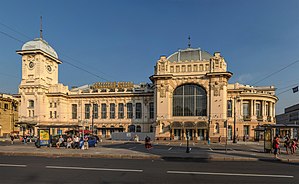Vitebsk train station
| Vitebsk train station | |
|---|---|

|
|
| Data | |
| Design | Terminus |
| Platform tracks | 8th |
| opening | 1837 |
| Architectural data | |
| Architectural style | Art Nouveau |
| architect |
Konstantin Thon (previous building), Stanislaw Brschosowski |
| location | |
| City / municipality | St. Petersburg |
| Place / district | Admiralty |
| City with subject status | St. Petersburg |
| Country | Russia |
| Coordinates | 59 ° 55 '11 " N , 30 ° 19' 45" E |
| Railway lines | |
| List of train stations in Russia | |
The Vitebsk Station ( Russian Витебский вокзал ) is one of five passenger stations ( terminal station ) in Russian Saint Petersburg .
Originally it was called Zarskoselski Woksal ( Царскосельский вокзал ) and after 1917 Detskoselski Woksal ( Детскосельский вокзал ), but these two terms, he was also in parallel according to the later end of the railway line as Vitebsk station called.
history
Vitebsk Railway Station is the oldest railway station in Russia. The first Russian railroad ran from Saint Petersburg to the Tsar's residence Tsarskoje Selo ( Russian Царское село , today Pushkin ). It was designed under the direction of the professor of the Vienna Polytechnic Institute Franz Anton von Gerstner and built until 1837. According to his plans, the terminus of the line should be on the bank of the Fontanka in downtown Saint Petersburg. However, due to a lack of money, the route was shortened and a modest wooden building was erected at the current location. The platforms were also made of wood. It was inaugurated on October 30, 1837 at the same time as the railway line was opened. It housed rooms for the passengers and service rooms for the staff. Next to the station building there were engine sheds, a forge and a workshop. The first train station in Saint Petersburg quickly became one of the city's attractions, with thousands of people flocking to it every day to see the new mode of transport.
The first trip from Saint Petersburg to Tsarskoye Selo took 35 minutes.
The wooden station building soon no longer met the requirements of the increased number of passengers. In the years 1849 to 1852, a two-storey station building made of stone was built according to the designs of the German-Russian architect Konstantin Thon . It stood in a row with the barracks on Sagorodny Prospect. In the following years the railway line was extended beyond Tsarskoye Selo to Vitebsk in Belarus. A reconstruction and expansion of the Vitebsk train station became necessary between 1874 and 1876.
By the end of the 19th century, the railway starting at the Vitebsk station developed into one of the main lines in the Russian Empire. It now linked the Russian capital with Odessa on the Black Sea . As a result, the inner-city railway system was lifted up to five meters by embankment, and between 1901 and 1904 the new, representative and still existing station building was built, which was designed by the architect S. A. Brschosowski ( С. А. Бржозовский ) and des Engineer SI Minasch ( С. И. Минаш ) was built in the Art Nouveau style. The platforms are located at the level of the upper floor and are covered by an arched structure made of steel and glass, designed by the engineer W. S. Gerson ( В. С. Герсон ). The Vitebsk train station appears in its silhouette with a dome in the middle of the building and a high clock tower. The spacious vestibule inside is equipped with a marble staircase, stucco decorations as female masks and a representation of the god Mercury , who is considered the protector of travelers and traders. On the walls there are pictures of the Petropavlovsk fortress (Kamchatka) and the port of Odessa (Ukraine), created by the artists W. I. Bystrenin ( В. И. Быстренин ) and A. S. Dudin ( С. И. Дудин ). In later years, more murals were added illustrating the history of the railway to Tsarskoye Selo and its stations.
The Pushkinskaya ( Пушкинская ) metro station has been located next to the train station since 1956 .
Since 1987, a model of the first Russian steam locomotive built by Jefim and Miron Tscherepanow has been housed in a glass pavilion.
In the years 2001 to 2003 for the 300th anniversary of Saint Petersburg, the Vitebsk train station was completely restored. All essential elements have been returned to their original state (dome, facade windows, parade stairs, "Imperial Café", etc.).
Suburban trains run from Vitebsk station to Veliky Novgorod, 180 kilometers away, as well as long-distance trains and the like. a. to Vilnius , Homel , Dnipro , Kaliningrad ( Koenigsberg ), Kiev , Lviv (Lemberg), Minsk , Odessa , Riga , Smolensk and Cherson .
Long-distance train to Riga
Web links
- General information about the train station (Russian) ( Memento from April 21, 2015 in the Internet Archive )
- On the history of Vitebsk train station (Russian)
- Architecture of the reception building (Russian)




